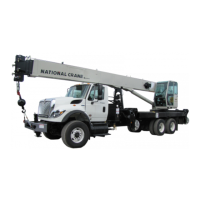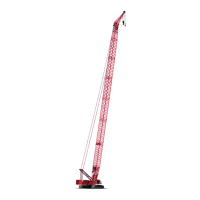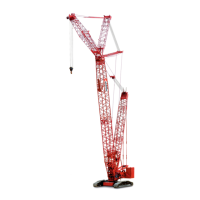1-22 1-21-2019 Control # 104-07
INTRODUCTION SERVICE MANUAL 1400A
Recommendations for Servicing Wire Rope
• Lock out equipment power when removing or installing
wire rope assemblies.
• Use safety glasses for eye protection.
• Wear protective clothing, gloves, and safety shoes.
• Use supports and clamps to prevent uncontrolled
movement of wire rope, parts, and equipment.
• When replacing fixed length cable assemblies (e.g.
pendants) having permanently attached end fittings, use
only pre-assembled lengths of wire rope as supplied
from Manitowoc CraneCARE. Do not build lengths from
individual components.
• Replace an entire wire rope assembly. Do not attempt to
rework damaged wire rope or wire rope ends.
• Never electroplate wire rope assemblies.
• Do not weld wire rope assemblies or components unless
recommended by the wire rope manufacturer.
• Do not allow welding spatter to come in contact with the
wire rope or wire rope ends.
• Do not allow the wire rope to become an electrical path
during other welding operations.
• Wire ropes are manufactured from special steels. If the
wire rope is heated, discard the entire length of rope.
• Wire rope sets must be replaced as a set.
• Do not paint or coat wire ropes with any substance
except approved lubricants.
Wire Rope Inspection
Inspect wire rope in accordance with the following
information excerpted from a National Consensus Standard
as referenced by Federal Government Agencies.
Recommended inspection intervals depend on the machine,
environmental conditions, frequency of lifts, and exposure to
shock loads. The inspection intervals may also be
predetermined by state and local regulatory agencies.
NOTE: Wire rope is available from Manitowoc
CraneCARE.
Record any deterioration of the wire rope in the equipment
inspection log. Determination of wire rope replacement must
be made by a qualified person.
Daily Inspection
A daily visual inspection is recommended for all ropes in
service. Use the daily inspection to monitor progressive
degradation and to identify damages that require wire rope
replacement such as:
• Distortion, kinking, crushing, un-stranding, bird caging,
reduction of diameter, etc.
• General corrosion.
• Broken or cut strands.
Yearly Inspection
Inspect the total length of wire rope annually or more often if
necessitated by adverse conditions. Only inspect the outer
surface of the wire rope. Do not attempt to open the strands
of the rope. Items to include in the yearly inspection are
items listed in the daily inspection plus the following:
• reduction of rope diameter below nominal diameter.
• severely corroded or broken wires at end connections.
• severely corroded, cracked, bent, worn, or improperly
applied end connections.
• areas subjected to rapid deterioration such as:
- sections in contact with saddles, equalizer sheaves,
or other sheaves where wire rope travel is limited.
- sections at or near terminal ends where corroded or
broken wires may protrude.
- sections in contact with stationary surfaces where
abrasion or chafing may take place as a result of
equipment vibration.
• boom nose sheaves, hook block sheaves, boom jib
sheaves, auxiliary boom nose sheaves, and hoist drums
for wear. Damaged sheaves or hoist drums can
accelerate wear and cause rapid deterioration of the
wire rope.
Boom Extension and Retraction Cables
Periodic Inspection
It is recommended that a weekly inspection of all boom
extension and retraction cables be performed using the
following guidelines. The inspection shall cover all visible
areas of the extension and retraction cables of an assembled
boom. Note that extending and/or retracting the boom may
be required to access visual inspection holes.
The inspection shall cover the entire length of the extension
and retraction cables of a disassembled boom prior to
reassembly.This inspection should be used to monitor
progressive degradation and to discover severe damages
necessitating wire rope replacement or equipment repair.
Inspect the rope for:
• reduction of rope diameter below nominal diameter.
• severely corroded or broken wires at end connections.
• severely corroded, cracked, bent, worn, or improperly
applied end connections.
Fo
r
Reference
Only

